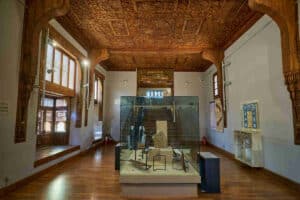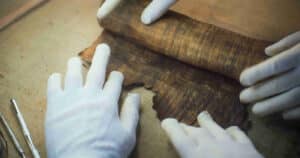The Coptic Museum of Cairo is, for many, one of the most pleasant surprises in the Egyptian capital. Especially for travelers who are more interested in the Christian religion, as this exhibition center offers an alternative to Ancient Egypt, which is the dominant theme in any trip through the country. In this post, we tell you what it is, where it is, and what are some of the masterpieces you shouldn’t miss.
What Is and Where Is the Coptic Museum of Cairo
The Coptic Museum of Cairo is the best place to learn about the history of Coptic Christians in Egypt, as it displays pieces and works of art from all over the country. It is located in the heart of the Coptic Quarter of the Egyptian capital, in a beautiful building from the early 20th century. Its exhibition area covers about 8,000 square meters, a short distance from other historical monuments in the area, such as the Babylon Fortress or the Hanging Church.
Its creator was Marcus Simaika Pasha, a prominent figure for this community in the past century, who set out to gather a rich collection on Coptic Christianity, so important in the initial formation of this religion since, according to tradition, St. Mark spread it through these lands in the times of Emperor Nero.
What Can Be Seen in the Coptic Museum of Cairo
The collection of the Coptic Museum of Cairo houses pieces that date from the first century, thus encompassing all the phases this religion has gone through in the country: from its clandestine emergence in the Roman era, through its enormous spread in the Byzantine era, to the fragile coexistence after the Arab invasion and even under Ottoman domination.
Closely examining the exhibited pieces allows one to admire the unique style of this religion in Egypt, which took elements from the ancient pharaonic civilization (symbols such as the ankh) but also others from the Byzantine empire (mosaics, icons, frescoes, etc.), without giving up traits in common with Islamic culture (wooden coffered ceilings, plaster reliefs, etc.).
This is a list of key works that you shouldn’t miss during your visit to the museum:
- Icon of St. Paul and St. Anthony: founders of the monastic movement in the Red Sea desert
- Ivory comb: refined piece with relief depicting the resurrection of Lazarus. From the Byzantine era (between the 4th and 7th centuries)
- Monumental keys of the Sohag monasteries. 12th-13th centuries
- Frescoes of the Virgin and Child: from the monastery of St. Jeremiah in Saqqara, from the 6th-7th centuries
- Tapestry of the flute player: 4th-5th centuries, a good example of mastery in textile works
- Fresco of Adam and Eve: from Fayum, 11th century
- Eagle, made in bronze in the 3rd-4th century, from the nearby Babylon Fortress. Symbol linked to St. John the Evangelist
- Icon of the Flight into Egypt, from the 18th century. Demonstration of the survival of the Coptic style in much more recent times
- Funerary stelae, from different monasteries, such as Al-Badari (Assiut), where the original designs of primitive crosses can be seen, so inspired by the Egyptian ankh
- Wooden toys from antiquity, reflecting the way Coptic children played centuries ago
Practical Information About the Coptic Museum of Cairo
If you are planning to visit the Coptic Museum of Cairo, take note of this useful information:
- Opening hours: every day, from 9:00 AM to 3:00 PM
- Price: Adults 280 EGP, Students 140 EGP. Egyptian or Arab adults 20 EGP, Egyptian or Arab students 10 EGP
- Address: 3 Mari Gerges, Kom Ghorab, Old Cairo, Cairo Governorate 4244001, Egypt




